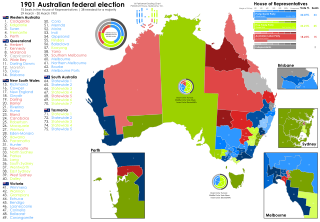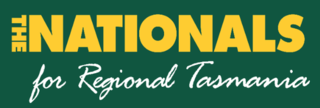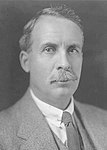The electoral system of Australia comprises the laws and processes used for the election of members of the Australian Parliament and is governed primarily by the Commonwealth Electoral Act 1918. The system presently has a number of distinctive features including compulsory enrolment; compulsory voting; majority-preferential instant-runoff voting in single-member seats to elect the lower house, the House of Representatives; and the use of the single transferable vote proportional representation system to elect the upper house, the Senate.

The 1901 Australian federal election for the inaugural Parliament of Australia was held in Australia on Friday 29 March and Saturday 30 March 1901. The elections followed Federation and the establishment of the Commonwealth of Australia on 1 January 1901. All 75 seats in the Australian House of Representatives, six of which were uncontested, as well as all 36 seats in the Australian Senate, were up for election.

The 1903 Australian federal election was held in Australia on 16 December 1903. All 75 seats in the House of Representatives, and 19 of the 36 seats in the Senate were up for election. The incumbent Protectionist Party minority government led by Prime Minister Alfred Deakin retained the most House of Representatives seats of the three parties and retained government with the parliamentary support of the Labour Party led by Chris Watson. The Free Trade Party led by George Reid remained in opposition.

Elections were held on 25 November 1967 to elect half of the 60 seats in the Australian Senate. There was no accompanying election to the House of Representatives as the two election cycles had been out of synchronisation since 1963. The results were a setback for the government of Harold Holt. Having won a landslide victory at the House-only election the previous year, the Coalition instead lost two seats in the Senate. The Labor Party failed to make any gains in Gough Whitlam's first election as leader; the Democratic Labor Party gained two seats and held the balance of power until 1974.
The following tables show state-by-state results in the Australian Senate at the 1901 federal election. Senators total 17 Free Trade, 11 Protectionist, and eight Labour. The terms were deemed to start on 1 January 1901. In each state, the first three elected received full six-year terms, and the three senators elected with the lowest number of votes retire after three years.
Section 13 of the Constitution of Australia provides for three aspects of the terms of members of the Australian Senate: the timing of elections, the commencement date of their terms and for the Senate to allocate long (six-year) and short (three-year) terms following a double dissolution of the Parliament of Australia. While members of the House of Representatives and territory senators have a maximum three-year term, state senators have a fixed six-year term, subject only to the parliament being dissolved by a double dissolution.
This is a list of electoral division results for the Australian 1901 federal election.

The Tasmanian Nationals are a political party in the Australian state of Tasmania, aligned with the National Party of Australia. The party is not currently registered with the Tasmanian Electoral Commission, and is not separately registered with the Australian Electoral Commission, unlike the other state branches of the Nationals.
The Australian states each elected three members of the Australian Senate at the 1903 federal election to serve a six-year term starting on 1 January 1904.
The Australian states each elected three members of the Australian Senate at the 1906 federal election to serve a six-year term starting on 1 January 1907.
The Australian states each elected three members of the Australian Senate at the 1910 federal election to serve a six-year term starting on 1 July 1910.
The Australian states each elected three members of the Australian Senate at the 1913 federal election to serve a six-year term starting on 1 July 1913.
Special Senate elections were held on 26 November 1966 to elect members to fill casual vacancies in the Australian Senate for the states of New South Wales, Victoria, Queensland and Western Australia.
This is a list of electoral results for the Australian Senate in Victoria since Federation in 1901.
This is a list of electoral results for the Australian Senate in Western Australia since Federation in 1901.
This is a list of electoral results for the Australian Senate in South Australia since Federation in 1901.
This is a list of electoral results for the Australian Senate in Tasmania since Federation in 1901.
This is a list of electoral results for the Australian Senate in Queensland since Federation in 1901.
This is a list of electoral results for the Australian Senate in New South Wales since Federation in 1901.
The 1917 Australian Senate election was held on 5 May 1917 to elect 18 of the 36 senators in the Australian Senate as part of the 1917 federal election. Each state elected three senators to serve a six-year term beginning on 1 July 1917.






